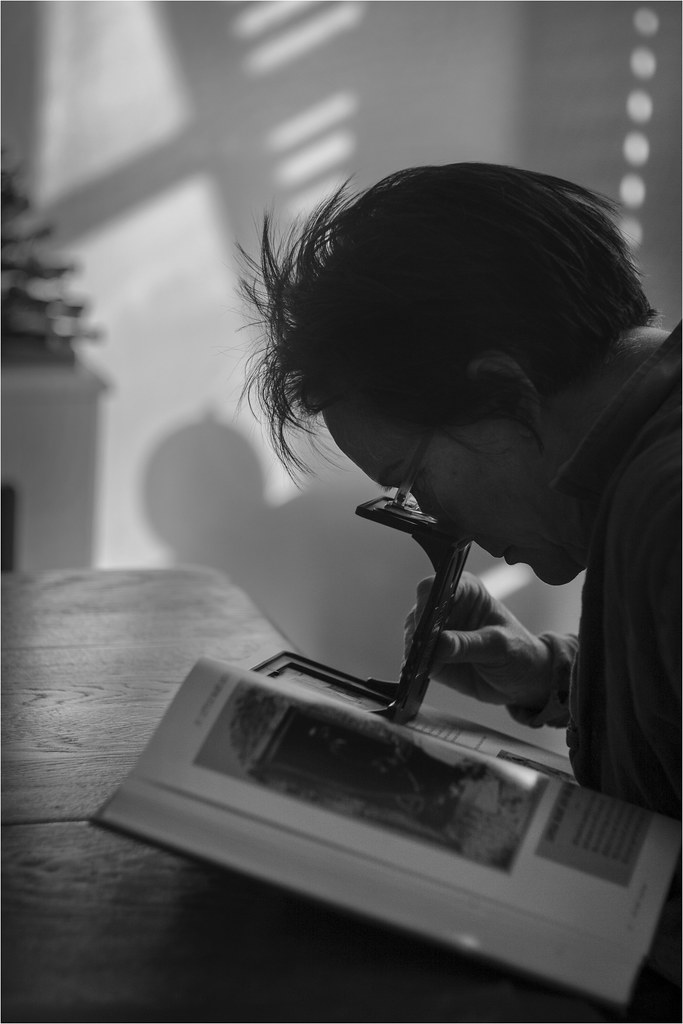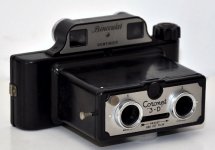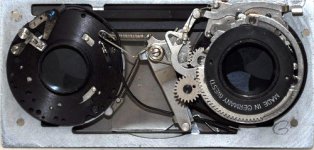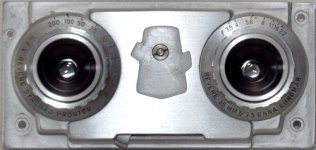louis
Member
For those of you who want to try a different way of rangefinder photography, I reccommend a rangefinder focusing 35mm stereo camera.
If you're sick of hearing about German, Russian or Japanese cameras, you'll be interested to hear that the finest stereo cameras were made right here in the good old USA!
Recently, a German company RBT has been making a good business custom joining 2 35mm SLRs into 1 stereo camera.
In my opinion, other than the RBTs, these two are the finest stereo cameras ever made.
1. The Stereo Realist with f2.8 4 element tessar-type 35mm lenses and a whopping 123mm rangefinder base! (is this the widest base for a 35mm camera?) Top shutter speed 1/200. Built like a tank with a leather covered cast aluminum body by Alcoa, had provision for intentional double exposures and even had an early hot shoe! Most are now over 50 years old and still in regular use. Some had Ektar lenses, some had German lenses. The last version, introduced in 1960 as the Custom Realist, had Kangaroo leather covering!
2. Wollensak Stereo 10
Made by Revere, also had 4 element f2.7 35mm tessar Wollensak lenses. It was slightly more deluxe than the Realist, brushed aluminum finish, with a top shutter speed of 1/300, and a bubble level built right into the viewfinder. Rangefinder base was a generous 74mm. Also had a leather covered cast aluminum body. This one is rarer than the Realist, so it commands a higher price.
They use regular 35mm slide film, you'll have to mount them yourself in stereo mounts which are still readily available, and your pictures will be far, far better than those taken with the Leica, Zeiss, Zorki or Kiev stereo adapter. Both the Realist and Wollensak-Revere also had high quality stereo slide viewers.
The cameras and viewers from both these manufacturers were not only fine tools but beautifully designed and finished; they'd look good in a display case.
If you're sick of hearing about German, Russian or Japanese cameras, you'll be interested to hear that the finest stereo cameras were made right here in the good old USA!
Recently, a German company RBT has been making a good business custom joining 2 35mm SLRs into 1 stereo camera.
In my opinion, other than the RBTs, these two are the finest stereo cameras ever made.
1. The Stereo Realist with f2.8 4 element tessar-type 35mm lenses and a whopping 123mm rangefinder base! (is this the widest base for a 35mm camera?) Top shutter speed 1/200. Built like a tank with a leather covered cast aluminum body by Alcoa, had provision for intentional double exposures and even had an early hot shoe! Most are now over 50 years old and still in regular use. Some had Ektar lenses, some had German lenses. The last version, introduced in 1960 as the Custom Realist, had Kangaroo leather covering!
2. Wollensak Stereo 10
Made by Revere, also had 4 element f2.7 35mm tessar Wollensak lenses. It was slightly more deluxe than the Realist, brushed aluminum finish, with a top shutter speed of 1/300, and a bubble level built right into the viewfinder. Rangefinder base was a generous 74mm. Also had a leather covered cast aluminum body. This one is rarer than the Realist, so it commands a higher price.
They use regular 35mm slide film, you'll have to mount them yourself in stereo mounts which are still readily available, and your pictures will be far, far better than those taken with the Leica, Zeiss, Zorki or Kiev stereo adapter. Both the Realist and Wollensak-Revere also had high quality stereo slide viewers.
The cameras and viewers from both these manufacturers were not only fine tools but beautifully designed and finished; they'd look good in a display case.
Lawrence Sheperd
Well-known
Resurrected from The Great Beyond. Just found my father's Wollensak 10 after having misplaced it for 40 years. I'm letting it acclimate before futzing with it. I'm almost in tears...I still have over 2000 metal mount stereo slides from our trips to Europe when I was a child, but I'm afraid the pink fungus has gotten hold of most of them....sigh.
Oh, BTW, wonderful forum. Glad I found you.
Oh, BTW, wonderful forum. Glad I found you.
roboflick
Well-known
I love my stereo realist! I just bought a 2.8 with the kodak ektar glass. Having it converted to 7 p. Who else on this list is shooting stereo? Anyone in Wisconsin?
Nik
Nik
Ambro51
Collector/Photographer
Bumping up a Stereo thread. Any discussions welcome!!
B-9
Devin Bro
Always wanted to hack one into a pano cam. No real interest in stereo for me.
GaryW
Member
Hello - New to the forum. Guessing this is as good a place as any to jump in. I've had a Kodak Retina 3C since HS - so that's a very long time now. Dad had one when we were growing up - a late 3c with the 3C light meter. I kinda went nuts when eBay started and spent some stupid money gathering all the 3C related toys. Included is a stereo attachment and a stereo viewer. I've shot several rolls of stereo over the years, and it's a lot of fun each time I go back to look at the photos. I've always loved the clarity of the Schneider Xenon lens, and I don't think the stereo attachment detracts from it a bit.
B-9
Devin Bro
Welcome Gary! Cool! As good as any reason to be here buddy.
Ambro51
Collector/Photographer
The more I study Stereo the more enthused I get! It’s a wonderful time to execute a stereo GAS attack as everything is available at modest cost. I’ve gotten enough gear and supplies at this time to get fully involved. I think camera choices are limited but excellent devices all. My personal GAS attack includes a pair of Stereo Realists, a TDC Colorist and arriving soon a Wollensak 10. I’ve gotten Realist aluminum masks and a Realist Green button viewer. Six rolls of Ektachrome and three of BW direct positive. Years ago I done a lot of 5x8 wet plate stereo and made Holmes cards.
EarlJam
Established
When I dug through my dad's camera accumulation in 2011, I came across a lens/shutter assembly from a Revere stereo camera. I suspect this came from Edmund Scientific, probably leftover parts. There was also a Coronet "3D" camera which used 127 rollfilm.
Attachments
Ambro51
Collector/Photographer
Surplusshed is still selling these lens assemblies. They own the Wollensak building in Rochester and many parts from their operation. Wollensak was founded in 1899 and later owned by Revere. Both the Revere 33 and the Wollensak 10 shared the same basic body. Revere built 27,000 stereo cameras while Wollensak produced only 4,000. To put those numbers in perspective, there were a 125,000 Stereo Realists built! The Wollensak 10 uses superior f 2.7 35mm Tessar lenses and has a top shutter speed of 1/300. Some feel it is the “best” stereo camera made. Interesting is that in all its years making cine Cameras the Wollensak 10 was the Only still camera made by them!
Vince Lupo
Nobody's Mentor
Bumping an old thread here -- my wife purchased one of Brian May's stereoscopic books a couple of weeks ago, and we're really getting a lot of enjoyment out of it. Of course I've now gotten bit by the stereo bug, and just ordered a Revere 33. Can any of you Revere experts impart any usage etc advice to a stereo newby?
mothertrucker
Well-known
For those looking for more stereo photography books there was a small run of stereo cards called "Hidden Depths" by Jacques Henri Lartigue available at:https://www.designforlife.com/
I bought a set a couple of years ago and it's really a great collection.
Vince - I don't have a Revere but I do have an old ICA Polyskop which I use. Stereo imagery is not the same ballgame as regular 2D photography.
Everything seems so much smaller in the final image - some artifact of putting this tiny little print or paired set of slides up to your face. I recommend deep focus (smaller aperture is better), plenty of sunlight, and either a grand setting like a canyon or a waterfall, or have many things of interest from foreground to background to make a good stereo effect.
One image in the Lartigue set I thought was really clever was a double exposure he made of a stairway and then a veiled figure coming down the same stair. The ultimate effect was a transparent, three dimensional phantasm. Really great.
I bought a set a couple of years ago and it's really a great collection.
Vince - I don't have a Revere but I do have an old ICA Polyskop which I use. Stereo imagery is not the same ballgame as regular 2D photography.
Everything seems so much smaller in the final image - some artifact of putting this tiny little print or paired set of slides up to your face. I recommend deep focus (smaller aperture is better), plenty of sunlight, and either a grand setting like a canyon or a waterfall, or have many things of interest from foreground to background to make a good stereo effect.
One image in the Lartigue set I thought was really clever was a double exposure he made of a stairway and then a veiled figure coming down the same stair. The ultimate effect was a transparent, three dimensional phantasm. Really great.
Vince Lupo
Nobody's Mentor
For those looking for more stereo photography books there was a small run of stereo cards called "Hidden Depths" by Jacques Henri Lartigue available at:https://www.designforlife.com/
I bought a set a couple of years ago and it's really a great collection.
Vince - I don't have a Revere but I do have an old ICA Polyskop which I use. Stereo imagery is not the same ballgame as regular 2D photography.
Everything seems so much smaller in the final image - some artifact of putting this tiny little print or paired set of slides up to your face. I recommend deep focus (smaller aperture is better), plenty of sunlight, and either a grand setting like a canyon or a waterfall, or have many things of interest from foreground to background to make a good stereo effect.
One image in the Lartigue set I thought was really clever was a double exposure he made of a stairway and then a veiled figure coming down the same stair. The ultimate effect was a transparent, three dimensional phantasm. Really great.
Many thanks -- interesting that you mention Lartigue. Back in 1993 I attended the opening of a Lartigue show (En Route Monsieur Lartigue) at the Palais de Tokyo in Paris, and one of the very clever things they did was to take some of his more famous images (like the one of racing cars with the skewed people in the background) and made them 3D. What they did was to get two large mirrors (like 30"x30") and arrange them in a V (so the point of the V was facing you). You stuck your nose against the point of the V - so that one eye was looking at the view in one mirror and the other eye was looking at the view in the other mirror - and you saw these amazing, large 3D black and white photos. I'd never seen anything like it before or since.
Here is one question I do have -- I'm considering scanning the negs and making my own little stereo cards. What's the best way to scan the pairs of frames? I have a Plustek 35mm only scanner, but I'm suspecting that the 'spread' between the two neg frames would be wider than 24x36mm, correct? Would I be better off using a 120 scanner?
Ambro51
Collector/Photographer
The problem with stereo today in 2020 is that hardly anyone is willing to “do it” like it was meant to be. That is, slide film correctly mounted and looked at through a hand held viewer. Nearly everyone wants some digital BS wrapped into the affair. .....just put the electronics down and enjoy stereo the proper way. Everything you need to know about Stereo is covered in “The Realist Manual”. It comes with plastic viewing glasses that let you see the book illustrations in 3D. •••••. The Revere 33 is a fine camera. Shoot it. Keep to the slowest speed film you can get.
aizan
Mentor
Thanks for the reminder. I've got to send my Stereo Realist red button viewer to be repaired. I cleaned a lot of battery corrosion out of it, but it still won't turn on.
David Hughes
David Hughes
Thanks Vince, that's the first mention I've come across of Lartigue in any forum for a long long time. I first came across his pictures when doing some research about 25 years ago, fascinating is the word for him and his photo's.
Regards, David
PS Forgot to mention the Olympus advert's using some of his shots, never mind...
Regards, David
PS Forgot to mention the Olympus advert's using some of his shots, never mind...
Vince Lupo
Nobody's Mentor
The problem with stereo today in 2020 is that hardly anyone is willing to “do it” like it was meant to be. That is, slide film correctly mounted and looked at through a hand held viewer. Nearly everyone wants some digital BS wrapped into the affair. .....just put the electronics down and enjoy stereo the proper way. Everything you need to know about Stereo is covered in “The Realist Manual”. It comes with plastic viewing glasses that let you see the book illustrations in 3D. •••••. The Revere 33 is a fine camera. Shoot it. Keep to the slowest speed film you can get.
I appreciate the sentiment, but what I’d like to initially do is try to make my own stereo cards. This Brian May book has given me the motivation. Maybe I’ll do slides at some point, but that’s my initial goal. And if I can meld digital BS into the equation, it doesn’t personally bother me. Having said that, I’ll have a look for the Realist Manual.
bob338
Well-known
I appreciate the sentiment, but what I’d like to initially do is try to make my own stereo cards. This Brian May book has given me the motivation. Maybe I’ll do slides at some point, but that’s my initial goal. And if I can meld digital BS into the equation, it doesn’t personally bother me. Having said that, I’ll have a look for the Realist Manual.
You should be able to find the Realist Manual on ebay fairly cheaply, or maybe even a download from the internet. It is a great book when you're starting out in stereo.
Making stereo cards is do-able, but slides are so much more fun to look at. If they still made Kodachrome 25, I would still be shooting stereo! If you do end up doing slides, look for RBT mounts until you really know what you're doing. Mounting slides in those pocket mounts never ends well and there is not much worse than out-of-alignment stereo, it will give you a terrible headache if they're not aligned perfectly. Spicer mounts are great and cheap once you have mounting down.
As for a viewer, a Realist red button is hard to beat. I use De Wijs viewers, and they're amazing, but they cost a LOT of money and are practically impossible to find any more. The Revere viewer is a stinker, but the TDC and Wollensak viewers are actually pretty good.
Your Revere camera is a good one. It's probably my favorite stereo camera in terms of functionality. The best lenses in a stereo camera are in the Belplasca, but it is a finicky camera and easily broken. Any Realist will be great, the German lensed ones being marginally better. I have standard f3.5s, 2.8s, and the elusive Ektar lensed cameras and I usually go back to my German f3.5. Speed is not usually important with stereo as stopping down gives you better pictures. Anything shot at f2.8 is not going to look good in stereo anyway, so don't waste your money on an f2.8 camera.
I'm full of useless information regarding stereo cameras so feel free to reach out with any questions you have.
Vince Lupo
Nobody's Mentor
Thanks Bob - a quick online search revealed that the Realist Manual can be had for anywhere from $25 on up ($25 seems to get you one in poor condition). And I’m not totally ruling out slides, just that the stereo cards are more on my mind at the moment.
The Brian May book my wife got came with its own stereoscopic viewer, and it works very well. I used to have one of those wooden ones from the 1800’s and a whole host of antique cards, but I sold it all off many years ago. The viewer that came with the book is similar in general design.

Stereo Riley by Vince Lupo, on Flickr
For those of you who are interested, here is Brian’s website: www.londonstereo.com
BTW maybe some of you shouldn’t look at it - he has a video on his FB page in which he shows you how to make stereo images with....an iPhone!
The Brian May book my wife got came with its own stereoscopic viewer, and it works very well. I used to have one of those wooden ones from the 1800’s and a whole host of antique cards, but I sold it all off many years ago. The viewer that came with the book is similar in general design.

Stereo Riley by Vince Lupo, on Flickr
For those of you who are interested, here is Brian’s website: www.londonstereo.com
BTW maybe some of you shouldn’t look at it - he has a video on his FB page in which he shows you how to make stereo images with....an iPhone!
Vince Lupo
Nobody's Mentor
Thanks Vince, that's the first mention I've come across of Lartigue in any forum for a long long time. I first came across his pictures when doing some research about 25 years ago, fascinating is the word for him and his photo's.
Regards, David
PS Forgot to mention the Olympus advert's using some of his shots, never mind...
I don’t know of too many photographers who had done much of their best work by the time they were 20!
Share:
-
This site uses cookies to help personalise content, tailor your experience and to keep you logged in if you register.
By continuing to use this site, you are consenting to our use of cookies.




